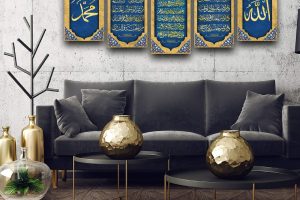Timeless Tradition: Decorating with Islamic Wall Art

Significance of Islamic Wall Art
Islamic wall art holds a profound significance that transcends mere decoration. It embodies centuries of cultural heritage, artistic expression, and spiritual meaning. For many, these artworks serve as a representation of faith, beauty, and identity within Islamic communities. Imagine walking into a home adorned with intricate geometric patterns or illuminating calligraphy; it can evoke feelings of peace and connection to history. The impact of Islamic wall art can be seen in various aspects:
- Timeless Tradition: Decorating with Islamic Wall Art
- Significance of Islamic Wall Art
- History of Islamic Art
- Influences and Evolution
- Symbolism in Islamic Wall Art
- Common Motifs and Their Meanings
- Types of Islamic Wall Art
- Calligraphy
- Geometric Patterns
- Materials and Techniques
- Traditional vs. Modern Approaches
- Placement and Decor Tips
- Creating a Harmonious Space
- Buying Guide for Islamic Wall Art
- Authenticity and Quality Considerations
- DIY Islamic Wall Art Projects
- Ideas and Inspirations
- Cultural Appropriation and Sensitivity
- Respecting the Art and Its Origins
- Cultural Heritage: Each piece tells a story of its origins and the artists who created them.
- Spiritual Reflection: Many artworks incorporate verses from the Quran, making them a constant reminder of faith.
- Aesthetic Appeal: The breathtaking designs enhance the beauty of any space, making it more inviting.
Whether used in homes, mosques, or public spaces, Islamic wall art not only decorates but also communicates the values and beliefs of a rich tradition. Understanding its significance is the first step in appreciating its beauty and depth.
History of Islamic Art
Influences and Evolution
Delving into the history of Islamic art reveals a rich tapestry woven from various cultural influences and evolving styles. The art form flourished as Islam spread across different regions, absorbing local customs and traditions. As one travels through time, the influences become apparent:
- Byzantine and Persian Art: The early Islamic artists drew inspiration from the intricate designs of Byzantine mosaics and the vivid colors of Persian textiles.
- Cultural Exchange: Trade routes linked the Islamic world to Africa, Europe, and Asia. This exchange led to a blending of artistic styles, as seen in the architectural marvels of Alhambra in Spain.
- Regional Variations: From the delicate floral designs in Mughal India to the bold calligraphy of Ottoman Turkey, each region brought its unique interpretation to Islamic art.
A personal favorite of many art enthusiasts includes the stunning arabesques and tessellations found in various mosques, showcasing both mathematical precision and spiritual depth. This exploration of influences and evolution not only highlights the diversity within Islamic art but also deepens our appreciation for its beauty and relevance today.
Symbolism in Islamic Wall Art
Common Motifs and Their Meanings
As one delves deeper into Islamic wall art, an intriguing layer emerges—the symbolism that enriches these stunning pieces. Each motif carries a meaning, often interwoven with the spiritual and cultural beliefs of the Islamic tradition. Here are some common motifs and their significance:
- Calligraphy: Beautifully styled Arabic script often features quotes from the Quran or declarations of faith, reminding viewers of their spiritual connection.
- Geometric Patterns: These intricate designs represent the infinite nature of Allah. The repetition symbolizes the vastness of creation and the unity of life.
- Floral Designs: Inspired by nature, floral motifs symbolize growth, beauty, and the transient nature of life, reminding viewers of the divine creation.
- Stars and Moons: Commonly associated with guidance and illumination, these symbols often reflect the Islamic calendar and its ties to time and spirituality.
A friend once shared how a wall adorned with Islamic floral patterns brought a sense of tranquility to her home, illustrating how these symbols transcend mere decoration to evoke emotions and reflections. Recognizing the deeper meanings enhances appreciation for the artistry and intent behind Islamic wall art.
Types of Islamic Wall Art
Calligraphy
One of the most prominent forms of Islamic wall art is calligraphy, often revered as the highest art form in Islamic culture. The beauty of calligraphy lies in its ability to convey faith through artistic expression. Each stroke embodies elegance, and the curves and lines create a visual rhythm that draws the viewer in. Personal experiences often highlight the profound impact of calligraphy. For instance, having a piece that displays the phrase “Bismillah” or “In the name of Allah” in graceful script can set a calm, spiritual tone in a space.
- Techniques: Artists typically use traditional pens made from reed or bamboo to create various styles, such as Naskh or Thuluth.
- Purpose: Calligraphic art often adorns mosques, homes, and public buildings, blending functionality with spirituality.
Geometric Patterns
In tandem with calligraphy, geometric patterns are another defining characteristic of Islamic wall art. These patterns are not merely decorative; they convey deeper philosophical concepts. The repetitive nature of these designs often symbolizes unity and continuity in creation:
- Mathematical Precision: Artists utilize mathematical principles to create stunning symmetry and balance, reflecting the harmony of the universe.
- Visual Complexity: The intricate tessellations can mesmerize viewers, inviting them to explore the complexity of faith and existence.
Many find joy in incorporating geometric patterns into their everyday lives, whether in ceramics, fabrics, or home decor. This dual appreciation for both calligraphy and geometric designs highlights the variety within Islamic wall art while reinforcing its spiritual and aesthetic value.
Materials and Techniques
Traditional vs. Modern Approaches
Exploring the materials and techniques used in Islamic wall art reveals fascinating contrasts between traditional and modern approaches. Each method brings its own charm and depth to artistic expression, allowing for a wide range of creativity. Traditional Techniques:
- Materials: Artists typically used materials like wood, plaster, tiles, and metal, each selected for its durability and ability to hold intricate designs.
- Craftsmanship: Traditional approaches involve meticulous handwork. Craftsmen often used tools like chisels and fine brushes to create stunning details in calligraphy and geometric patterns.
For example, visiting a historical mosque often leaves visitors in awe of the handcrafted tile work and intricate carvings that tell stories of faith and art. Modern Approaches:
- Incorporation of New Materials: Today, artists might use acrylics, digital tools, or even spray paint, offering them greater flexibility and innovation.
- Hybrid Art Forms: Many contemporary Islamic artists blend traditional motifs with modern aesthetics, resulting in fresh perspectives that resonate with newer audiences.
The blend of traditional and modern techniques not only keeps the art of Islamic wall decoration alive but also ensures its relevance in contemporary culture. This evolution speaks to the adaptability of Islamic art while honoring its rich heritage.
Placement and Decor Tips
Creating a Harmonious Space
Successfully incorporating Islamic wall art into any setting requires careful consideration of placement and overall decor. The goal is to create a harmonious space that evokes tranquility and spiritual connection. One popular approach is to curate a dedicated wall or area that allows these pieces to shine:
- Focal Points: Choose a prominent wall in your living room or entryway to display larger pieces. This helps create a visually stunning focal point that draws people in.
- Grouping: When using multiple artworks, consider grouping smaller pieces together. Arranging them in a gallery style can create a dynamic visual experience.
For example, a friend of mine transformed her meditation room by hanging delicate calligraphic art alongside geometric patterns, resulting in a serene atmosphere that enhances her practice. Additional Tips:
- Lighting: Install soft lighting to accentuate the textures and colors of the artwork, creating a warm and inviting ambiance.
- Complementing Decor: Use complementary colors and materials in your furniture and textiles to further unify the space.
These thoughtful strategies can elevate any room, allowing the beauty and meaning of Islamic wall art to resonate deeply within the environment.
Buying Guide for Islamic Wall Art
Authenticity and Quality Considerations
When it comes to purchasing Islamic wall art, ensuring authenticity and quality is crucial. Not only does this respect the cultural heritage behind the art, but it also guarantees that you are adding a true representation of the art form to your space. Authenticity:
- Provenance: Seek artworks with a clear history or background. Reputable sellers will provide details on the artist or the origin of the piece.
- Artisan Credentials: Supporting local artisans or galleries that specialize in Islamic art ensures that you are purchasing genuine creations, often imbued with rich craftsmanship.
A close friend once recounted her experience buying a piece directly from a craft fair, feeling a deeper connection after learning about the artist’s inspiration and techniques. Quality Considerations:
- Material Assessment: Check for high-quality materials. Authentic Islamic art often employs durable mediums like wood, metal, or fine canvas.
- Craftsmanship: Inspect the details. Well-crafted pieces will exhibit meticulous attention to detail, whether in calligraphy or geometric design.
By taking the time to focus on authenticity and quality, you can confidently invest in Islamic wall art that truly resonates with both your taste and respect for this beautiful tradition.
DIY Islamic Wall Art Projects
Ideas and Inspirations
Creating Islamic wall art at home can be a rewarding and enlightening experience, allowing individuals to connect with their creativity while embracing cultural appreciation. Here are some engaging DIY project ideas and inspirations to help you get started:
- Calligraphy Canvas: Use acrylic paints to create your own calligraphic art. Choose a meaningful phrase or verse from the Quran, and apply decorative techniques, such as gilding or layering colors, to enhance the piece.
- Geometric Stencils: Craft your geometric patterns using stencils. Simply trace them on canvas or wood and paint with vibrant colors. This not only adds a pop of color but infuses your space with cultural richness.
- Mosaic Art: Gather small tiles or colored paper to create a mosaic design reflecting traditional Islamic patterns. This project allows for personal expression and can be a fun activity for families.
From personal experience, one can attest that displaying handmade pieces adds a unique touch to home decor. The process of creating your art gives a sense of pride and intentionality, making the space feel more personal and connected to cultural roots.
Cultural Appropriation and Sensitivity
Respecting the Art and Its Origins
As we embrace the beauty of Islamic wall art, it’s crucial to approach it with respect and sensitivity, particularly concerning cultural appropriation. This art form is rich in history and meaning, and understanding its origins enhances both appreciation and responsibility. Understanding Cultural Context:
- Cultural Significance: Recognize that many Islamic artworks are deeply spiritual and are often tied to religious practices and the community’s identity. It’s important to respect these connections while appreciating the art.
- Avoid Stereotypes: Be mindful of how you display these artworks. Avoid presenting them in a manner that reduces complex cultural narratives to mere decoration or trends.
A friend once shared her experience of integrating Islamic art into her decor, and she made it a point to learn about the artists and techniques involved. This understanding led to meaningful conversations about cultural heritage with her visitors. Promoting Authenticity:
- Support Artisans: Whenever possible, purchase from artisans and galleries that prioritize authentic representations of Islamic art. This not only supports the culture but also fosters genuine appreciation.
Approaching Islamic wall art with respect for its origins ensures that we celebrate the artistic beauty while honoring the traditions behind it. Building this awareness cultivates a deeper connection to the art and its cultural roots.





